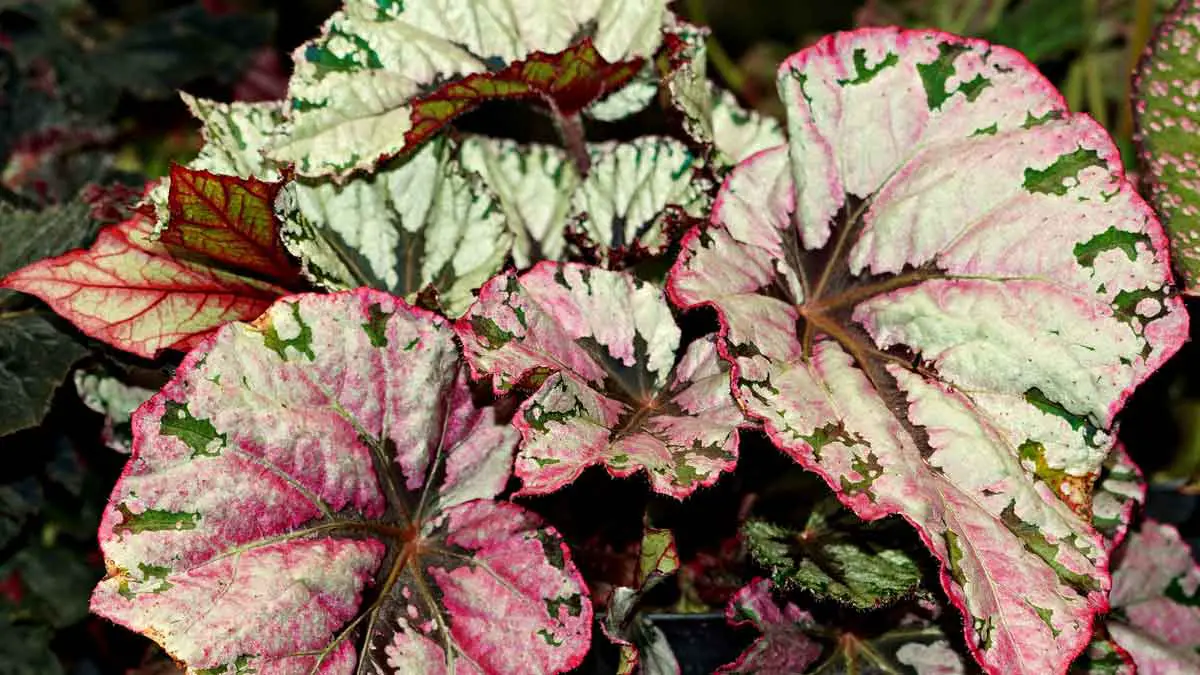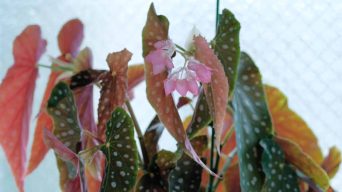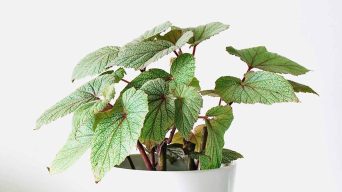Begonia root rot is caused by overwatering, poor drainage, and infections, leading to darkened foliage and rotting roots. Treatment involves removing affected parts, improving drainage, and using fungicides. Prevention includes proper watering and maintenance.
Root rot can be a devastating issue for plant enthusiasts, causing severe damage to the health and appearance of your beloved Begonias.
In this guide, we will explore the causes, treatments, and preventive measures you can take to ensure that your Begonia plants remain vibrant and free from this common fungal disease.
Understanding Root Rot
Root rot is a common yet devastating issue affecting various plants, including the beautiful Begonia.
It occurs when plant roots are exposed to excess water or poor drainage conditions, leading to a lack of oxygen supply for the roots.
In particular, Begonias are susceptible to a fungus-like organism called Pythium ultimum, which causes root rot in these plants.
The fungus survives within the soil as resting structures known as oospores. It is activated when there’s excess moisture present in the growing medium.
To ensure healthy growth of your Polka Dot Begonia (Begonia maculata), Angel Wing Begonia (Begonia coccinea), Rex Begonia (Begonia rex-cultorum), Wax Begonia (Begonia semperflorens), or any other popular varieties; it is crucial to be familiar with early signs of root rot such as discolored or mushy roots and yellowing leaves.
Catching these symptoms early on could save your precious indoor tropical plant from irreversible damage caused by this insidious fungal disease.
Causes Of Begonia Root Rot
Overwatering, poor drainage, and fungal infections are the leading causes of root rot on Begonia plants.
This common issue can harm the plant’s growth and survival.
Understanding the reasons behind the problem is essential to prevent and treat it effectively.
Keep reading to learn more about the causes of begonia root rot and how to manage it.
Overwatering
Overwatering is a common cause of root rot. It directly contributes to developing an unhealthy environment for your precious plant.
Like many other houseplants, Begonias requires a delicate balance between moisture and drainage to thrive.
In addition to causing immediate damage, consistently overwatered Begonia plants become vulnerable to fungal diseases like stem rot and powdery mildew.
For example, if you notice that your Begonia continues wilting even when its potting mix is wet, this may indicate root rot caused by overwatering.
Poor Drainage
Poor drainage significantly contributes to root rot on Begonia plants, as it creates an environment conducive to fungal growth and decay.
When water cannot easily escape the pot or soil, it leads to overly saturated conditions that can harm your Begonia.
Moreover, the soil type also plays a crucial role in ensuring proper drainage for your begonia plant.
A dense and heavy potting mixture retains too much moisture, making it difficult for excess water to drain away from your plant’s roots effectively.
Fungal Infections
Fungal infections are a common cause of begonia root rot.
The Rhizoctonia fungus and Botrytis stem rot can quickly spread through the soil, attacking the roots and stems of your begonia plant.
These fungi thrive in wet environments, making it important to avoid overwatering your plants and ensure proper drainage.
Infected roots may initially have small dark brown to black bands where the infection occurs.
If left untreated, these fungal diseases can kill your plant.
Signs Of Begonia Root Rot
Identifying the signs of begonia root rot early on is important to prevent it from spreading further.
Here are some common signs to look out for:
- Darkened Foliage: Begonia plants infected with root rot may have dark brown or blackened leaves. This discoloration is caused by the fungus infecting the roots and preventing proper nutrient uptake.
- Wilting: Plants affected by root rot will start to wilt and droop, even if they have been watered recently. This is due to the damaged roots being unable to support the plant.
- Blackened Stem: The stem of a begonia plant infected with root rot may turn black and become soft to the touch. This is a sign that the fungus has spread from the roots into other plant parts.
- Mushy Roots: When you inspect the root system of an infected plant, you may notice that the roots have become mushy and black. This is a clear indication that your plant is suffering from root rot.
Treatment Of Begonia Root Rot
You must take several steps to revive your plant to treat root rot on your Begonia.
First, remove infected areas and trim the roots before applying a fungicide to the soil.
Afterward, repot the plant using clean and sterilized soil with proper drainage.
In severe cases, watering the plant with a soil drench of potassium phosphite or hydrogen peroxide may also be necessary.
Removal Of Infected Areas
When treating Begonia Root Rot, removing infected areas is an essential step.
Here are the steps you should take:
- Start by removing any visibly infected leaves or stems from the plant.
- Cut off any mushy or discolored roots using clean scissors or pruning shears. Be careful not to damage healthy roots while doing so.
- If the root rot has spread extensively, removing and disposing of the entire plant may be necessary to prevent the disease from spreading.
- After removing all infected areas, sterilize your tools using rubbing alcohol or bleach.
Pruning Of Infected Roots
When dealing with Begonia root rot, pruning infected roots is an essential step in treatment.
Here’s how to do it:
- Use sterilized pruning shears to carefully remove any visibly infected roots carefully, ensuring not to damage healthy roots.
- Cut the infected roots back to healthy tissue, and discard the affected material in a sealed bag or container.
- After pruning, apply a fungicide treatment to the remaining healthy roots and soil surrounding the plant.
- Monitor the plant closely for any signs of regrowth or further infection and continue with appropriate treatment as needed.
Use Of Fungicides
Fungicides can be effective in treating root rot caused by fungal infections.
For example, benzimidazole fungicides like thiophanate-methyl help control black root rot, a common disease caused by the fungus Thielaviopsis basicola.
These fungicides work by inhibiting cell division and growth of fungi, ultimately killing them off.
It’s essential to follow the instructions carefully when using fungicides and ensure they are safe for your specific type of begonia plant.
One way to prevent the need for fungicide treatment is to avoid overwatering your begonia plant, as excess moisture provides a favorable environment for fungal growth.
Furthermore, ensuring proper drainage and good air circulation around your plants can help keep them healthy and disease-free.
Repotting The Plant
Repotting your Begonia plant is vital in treating and preventing root rot.
Here’s how to do it:
- Choose a pot that is just slightly larger than the current one.
- Fill the bottom of the new pot with fresh, well-draining soil.
- Gently remove the plant from its old pot, careful not to damage the roots.
- Remove any dead or damaged roots, as well as any infected soil.
- Place the plant in the new pot and fill in around it with fresh soil, making sure not to cover the stem or leaves.
- Water thoroughly and let drain.
Spring is the best time for repotting Begonia plants, ideally every three years with houseplant compost.
Repotting should be done 24 hours after watering the plant to reduce the risk of damaging the root hairs.
Soil Sterilization
Soil sterilization is a highly recommended treatment for begonia root rot.
It involves heating the soil to kill off harmful organisms and prevent them from spreading the disease.
Sterilizing the soil or media before replanting can also help prevent future outbreaks of root rot.
You can use an oven, microwave, or a specialized sterilizer machine to sterilize your soil.
Simply place the moist soil in an oven-safe container and heat it at 180-200 degrees Fahrenheit for about 30 minutes.
Just be sure to let it cool down completely before using it again.
Prevention Of Begonia Root Rot
You can take several measures to prevent root rot, such as using appropriate watering techniques, providing ample drainage, selecting the correct soil and potting mixture, ensuring proper air circulation, and quarantining new plants.
These actions will help maintain the health of your Begonia plants and avoid root rot.
Proper Watering Techniques
Proper watering is crucial for preventing begonia root rot.
Here are some techniques to ensure your plant stays healthy and free from root rot:
- Water your Begonia when the top inch of the soil feels dry. Overwatering can cause standing water in the pot, leading to root rot.
- Use room temperature water to avoid shocking the roots with cold water.
- Avoid watering too frequently or too little. Begonias like to be kept evenly moist but cannot tolerate being overwatered or underwatered.
- Water at the base of the plant, avoiding getting the leaves wet as this can lead to stem and root rot.
- Ensure proper drainage by choosing a pot with drainage holes and using well-draining soil.
Remember that symptoms of overwatering or underwatering can also indicate issues that need addressing for a healthy plant.
Adequate Drainage
Adequate drainage is one of the most important preventative measures for root rot.
Waterlogged soil restricts the flow of oxygen to the roots, which can cause them to rot over time.
To prevent this, ensure good drainage holes in your pot and choose a well-draining mix containing perlite or vermiculite.
Begonias thrive when their roots have access to plenty of air.
With proper drainage, you can help maintain healthy roots, preventing root rot and other fungal diseases from taking hold.
Choosing The Right Soil
To prevent begonia root rot, choosing the right soil for your plant is essential.
A peat-based mixture or a combination of equal parts soil-based potting mix and coarse leaf mold is an ideal choice for potting and repotting begonias.
Avoid wet soils, as they can expose your plant to fungal diseases leading to stem and root rot.
You may also want to ensure the pot has adequate drainage holes to allow excess water to drain away from the roots.
Providing Good Air Circulation
Good air circulation is crucial in preventing root rot as it helps to reduce the humidity and moisture levels around the plant.
When there’s stagnant air, it creates a breeding ground for fungal diseases like root rot.
In addition to increasing airflow, you should also make sure that there’s enough space between plants.
This will help prevent overcrowding and limit the spread of disease in case one plant gets infected.
Another way to improve air circulation is by pruning off yellow leaves or branches touching other plants or walls.
These areas tend to hold onto moisture and create a damp environment perfect for fungal growth.
Quarantine New Plants
To prevent the spread of diseases like Pythium, it’s important to quarantine new plants before introducing them to a garden or greenhouse.
This means keeping them separate from your other plants for some time and monitoring them closely for signs of disease.
When purchasing new begonias, inspect the leaves and stems for any discoloration or spots that could indicate infection.
If possible, ask the seller if they’ve had any issues with a disease in their stock.
Final Thoughts
Root rot on Begonia plants is a serious problem that can quickly kill your beloved plant.
Understanding the causes, signs, and treatment options can help prevent this fungal disease from taking hold in your garden or indoor space.
Remember to quarantine new plants before introducing them into your collection. Look for any signs of wilting or yellowing leaves that could indicate Begonia leaf problems.







